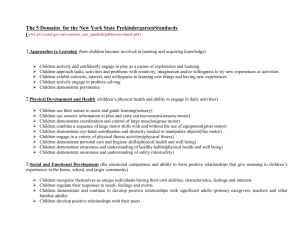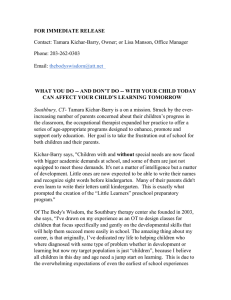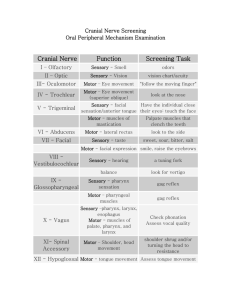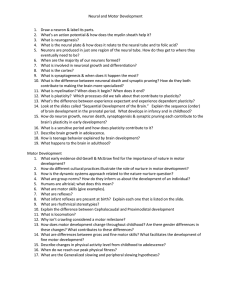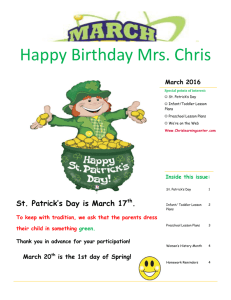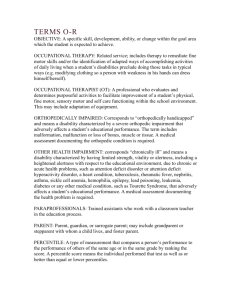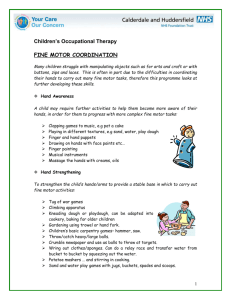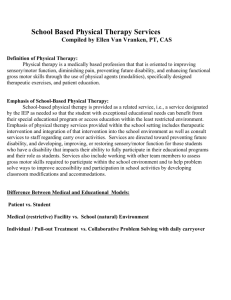Get Smart with Art - VSA Massachusetts
advertisement
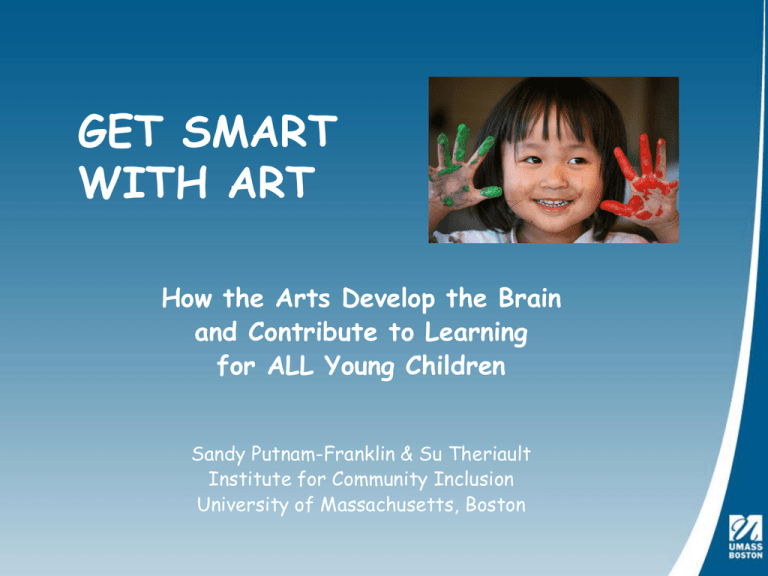
GET SMART WITH ART How the Arts Develop the Brain and Contribute to Learning for ALL Young Children Sandy Putnam-Franklin & Su Theriault Institute for Community Inclusion University of Massachusetts, Boston How Art Makes You Smart What is arts education? • • • • Movement and Dance Music Theatre Arts Visual Arts Research Reinvisioned for the 21st Century Early Arts Education • Exploration • Experimentation • Engagement of the senses • Discussion Guiding Principles for Arts Education •The goal of arts education for young children is to develop and sustain their natural curiosity, expressiveness, and creativity. •Arts education begins with a foundation that emphasizes exploration, experimentation, engagement of the senses, and discussion as paths to understanding. Massachusetts Guidelines for Preschool Learning Experiences (2003) Best Practices for Arts Experiences with Young Children • Provide developmentally appropriate materials, equipment, activities. • Provide opportunities to explore a variety of materials, media, tools. • Extend children’s learning with verbal stimulation Universal Design is the design of products and environments to be usable by all people, to the greatest extent possible, without the need for adaptation or specialized design. - Ron Mace, Architect Universal Design considers the needs of the broadest possible range of users. • • • • Benefits of Universal Design Increases access for all Encourages students to participate and try new ideas Increases retention of all students Respects individual learning styles Accommodations • Support one student • Require extra planning time • Highlight differences Either Accommodations or UD Both Accommodations and UD + What does Universal Design for Learning mean in early childhood? Creating environments, curriculum, and assessment strategies that accommodate the widest variety of young children’s learning styles and needs. It also involves including families in the process. Key Elements of Universal Design in Early Childhood Education • • • • Environment Curriculum & Instruction Assessment Family involvement The Arts Contribute to the Development of the Whole Child • • • • • • Brain development Gross motor development Fine motor development Visual memory development Social-emotional development Cognitive development Brain Development Neural Plasticity • The brain’s greatest capacity for change occurs during the early years Integration • There needs to be good communication (integration) between both sides of the brain Neural Plasticity Use It or Lose It The human brain at birth 6 Years Old 14 Years Old Multiple Means of Engagement: Practice and Repetition Integration of the Left/Right Hemispheres of the Brain http://www.brain-based-learning.com Sensory Perceptual Development A process in which the child develops the skill and ability to take in, interpret, and respond to information from the environment. Sensory Experiences • • • • • • • Finger painting Handling textures Finger plays Coloring Play dough, clay Paper activities Manipulative activities Physical activities have cognitive value. • • • • Physical education and recess Gross motor activities Sensory motor experiences Combine movement and music Movement and dance affect body and brain development. • • • • • • • • • Position in space Directionality Strength Body control/coordination Balance Flexibility Functional movement patterns Personal space Expression Provide variety in movement. Locomotor Elements of movement: rolling, crawling, creeping, walking, running, jumping, hopping, galloping, sliding, climbing sequences expression props Non-locomotor bending, twisting, turning, stretching, shaking, curling, swinging, rocking, swaying, reaching Move met and Danc e Response to rhythms classical jazz swing disco tribal Ethnic Contrasts of movement: hard/soft strong/light fast/slow stiff/floppy Windows of Opportunity for Motor Development •Basic gross-motor skills: prenatal to age 5 •Fine motor skills: birth to age 9 Vestibular Stimulation Move in, move up, move all around Keep the brain and body sound The more you move The more you’ll prove That spinning and turning Are good for learning! - From Learning With the Body in Mind by Eric Jensen Visual Arts • Art is way of thinking and demonstrating the product of thinking. • Visual learning = improvement in reading, creativity, math scores. • Drawing complements the writing and thinking process. • Drawing forces us to visualize and plan our actions. • Early exposure to visual images are critical to stimulate the brain. • Visual tools can help students think. The Link Between Drawing and Writing Both: • Are ways of using pictorial and written symbols to represent ideas and feelings • Involve psychomotor skills • Depend on similar cognitive abilities • Involve expressive arts • Are developmental Fine Motor Skills • Grasp • Strength • Control • Dexterity • Hand dominance Language and Literacy Development “As early as age three or four years, children can recite poetry, memorize, invent, and perform finger plays, and begin rhyming words. These are some of the fundamental tools for developing language skills.” - Goals 2000 Task Force Report Expose young children to art resources. •Display reproductions of art •Read children’s books about artists in various fields •Visits to art museums, galleries and local studios •Guest artists visits to classrooms •Children’s books that help them develop appreciation of art concepts and art work Engage young children in talking about art. • • • • • • Ideas Process Materials Knowledge/concepts/vocabulary Reflection Planning Children with language-related delays and children who are second-language learners especially benefit from having their experiences and understandings communicated through art, a nonverbal form of expression that is readily available to them. - Sounda, Guha & Qiu, 2007 The Effects of Music on Brain Development and Learning “Music… excites inherent brain patterns and promotes their use in complex reasoning tasks.” - Black, 1997 Research suggests that music… • Facilitates reading • Facilitates awareness and discrimination of sounds • Enhances visual-motor skills • Regulates stress • Enhances memory systems - Eric Jensen, Arts With the Brain in Mind Dramatic Arts Children… benefit from play-based instruction in which they invent dramatic play scenarios. Sociodramatic play increases oral language use and enables children to plan, negotiate, compose, and carry out the “script” of their play. These skills are related to the development of reading comprehension. - Snow et.al. (1998) Preventing Reading Difficulties in Young Children Social/emotional Development • Self concept • Confidence • Expression of feelings • Communication of ideas • Relationships • Respect • Understanding of others • Community Provide ALL young learners… • • • • • Enough time to express themselves Safety to experiment Respect for their work and their efforts Interest so the child wants to continue Support for a wide range of expression Provide ALL young learners variety in… • Formats: large/small, vertical/flat • Surfaces: papers, textures, wood, cloth • Media: tempera paint, finger paint, water color, markers, chalk (wet/dry), photography, sculpture, construction, fabric, paper, wood • Locations: areas of the room; indoor/outdoor • Social groupings: solo, partners, small group, large group The Ultimate Test: 4 Key Questions 1. Are ALL children able to experiment freely with art and explore what happens? 2. Will each child’s work look different from the others? 3. Is the goal of the activity the children’s enjoyment rather than a product to please adults? 4. Will the child’s effort lead to something that is satisfying to the child at his or her level of development? Research on the Arts and Learning Online Resources Critical Links: Learning in the Arts and Student Academic and Social Development http://www.nasaa-arts.org/publications/criticalevidence.pdf Report on Learning, Arts, and the Brain: http://www.dana.org/uploadedFiles/News_and_Publicati ons/Special_Publications/Learning,%20Arts%20and%20 the%20Brain_ArtsAndCognition_Compl.pdf


